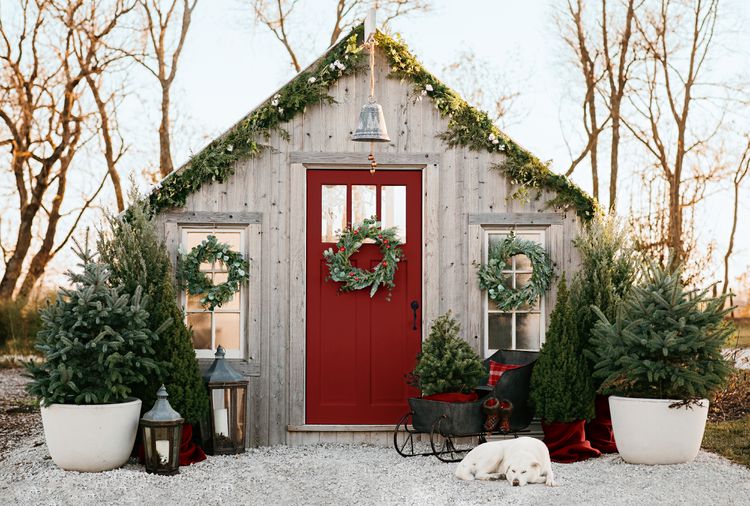Decking the halls with fresh greenery is earth-friendly and easy on your wallet. Winter landscapes offer many festive possibilities for natural Christmas decor. Evergreen trees have richly colored needles that are ideal for making garlands and wreaths, while winter berries provide bold pops of color to tablescapes and holiday arrangements.
This list contains an assortment of colorful and long-lasting fresh greenery you can use to decorate with this holiday season. You might already have some of these plants growing in your yard, or you can forage them from the wild (where you have permission to do so). Purchasing precut branches from Christmas tree farms or plant nurseries may also be an option.
Pine
Many species of pine trees are native to North America, including white pines, red pines, and longleaf pines. If you hike in the woods, you can forage a few pine branches to decorate your mantel. You can also use pine branches to make kissing balls and wreaths.
One of the perks of pines is that they have relatively soft needles, so they’re easy to work with, and they have a strong scent that makes your home smell like the holidays.
Fir
Like pines, firs are often sold as Christmas trees; they are some of the most fragrant evergreens to use for holiday decorating. If you purchase a live Christmas tree at a local tree farm, you can ask to keep the lower branches, which are often trimmed away before you take your tree home. You can also forage for branches from native firs, like Douglas and Fraser firs, and use the branches to make wreaths and centerpieces for your holiday table.
Holly
Hollies are popular landscaping plants, so there’s a good chance you may already have a few holly bushes growing in your garden. The most popular holly to grow in landscapes is the common holly, which is a European species, but there's also American holly (shown here), which is just as stunning in holiday container arrangements and other decor. Holly shrubs boast glossy leaves that add interest and texture to wreaths and floral arrangements, but most people cherish hollies for their bright red berries.
Cedar and Cypress
Cedars and cypress trees are often confused because their names are used interchangeably. However, true cedars come from the Old World, and they’re often used in landscape designs, such as the Atlas cedar shown here. The native North American trees we know as “cedars” (including arborvitae) belong to the Cypress family. Names aside, both cedar and cypress branches make stately additions to holiday arrangements, and many of these trees emit a pleasant fragrance that adds festive cheer to your home.
Juniper
Several species of juniper plants are native to North America; you can find them growing in many backyard gardens. When cut, juniper branches will perfume your home with their rich and spicy scent, but these plants are most prized for their attractive, dark blue berries. Juniper branches can be spread along mantlepieces, gathered into kissing balls, tied into garlands, or used as wreath accents.
Hemlock
Hemlocks are easy to find in the North American woods, but they’re often grown in gardens, too. Compared to pines, hemlocks usually have shorter needles, making them easier to work into kissing balls, and their soft needles won’t prick your fingers when you’re crafting with them. For more options, you can use hemlock cones as holiday accents or glue mini ornament hooks to them and hang them on your Christmas tree.
Spruce
Spruce trees are often sold as Christmas trees, but you can also find them growing wild in North America. Most people are familiar with the showy blue spruce, which sports bright, bluish-green needles, but you can also find white, black, and red spruce trees. Spruce tree branches are sturdy enough for wreath-making, and they also look lovely in a vase, but spruce needles are rather prickly, so wear gloves when handling them.
Winterberry
Winterberry is a type of holly commonly grown as a winter interest garden plant. Unlike other hollies, winterberry loses its leaves in winter, but its bright red berries stay put and provide an important food source for birds in winter. Place winterberry branches in a vase to create a minimalist holiday display, or weave them into your Christmas tree for an extra color accent.
Rosehips
Rosehips aren’t traditionally used for holiday decor, but their bright red color makes them plenty festive. Many birds rely on rosehips for food during the winter, so follow the old “foraging rule” and don’t harvest more than 1/10 of the rosehips you see so that wildlife can continue to nibble on them. Like winterberries, rosehips can be placed in vases, or they can be woven into your Christmas tree for extra color.
Some roses are invasive, so be sure not to drop any hips while gathering them. And burn or bag them when you're ready to dispose of the hips.
Grapevines
Grapevines make super-sturdy wreath forms. If you grow edible grapes, you may already have vines growing in your garden, but you can also find native grapes in the wild. The beauty of harvesting grapevines in winter is that they won’t have any leaves, so they’ll be easy to spot in the trees.




















